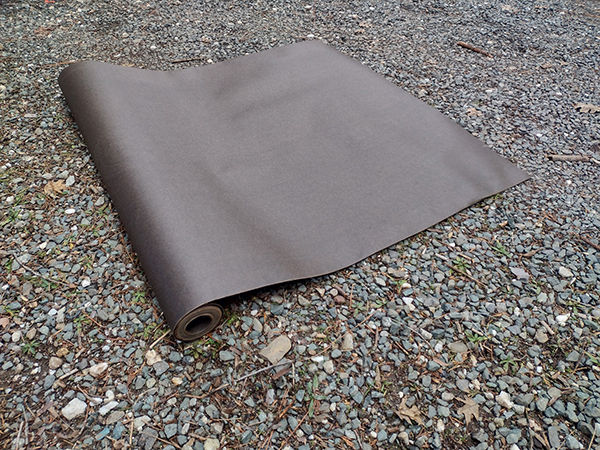It's quite common to come across a layer of black paper when starting a new stucco project or when you start renovating a stucco home and this paper is usually found behind the base and finish coats of the stucco, hidden underneath the layers.
This particular layer is crucial for maintaining the integrity and functionality of the stucco system and is generally referred to as "Grade D building paper".
What Is Grade D Paper?
In the stucco application process, Grade D paper is a key element that provides a water-resistant shield between the stucco exterior and the structural parts of a building and is typically the first element that is installed. This type of paper is distinguished by its thinner profile and is highly water-resistant, which is achieved through infusing asphalt into the paper itself.

Through this process, the paper not only obtains a distinctive black color but also enhances its ability to repel moisture. Despite its thinness, Grade D paper is available in various weights, reflecting differences in thickness and, therefore, its effectiveness as a protective barrier.
The Choices You Have: If you were to look at the choices of paper out there, you would be asked what type of paper you would like to use and terms such as "10 minute" and "60 minute" paper would then be used to differentiate the options available. There are more options that are available but these are the two most common types used.
*** It's important to note that these terms don't actually refer to time, but instead indicate the thickness of the paper and its theoretical strength when subjected to specific testing conditions.
How They Differ: A "10 minute" Grade D paper is on the thinner end of the spectrum, offering a basic level of protection suitable for areas with less exposure to moisture. On the other hand, "60 minute paper" is significantly thicker, providing enhanced protection against water infiltration, which is more important in regions prone to heavy rain or where the stucco will face prolonged exposure to moisture.
What Purpose Does it Serve?
The black paper (Grade D building paper), serves a crucial purpose behind stucco exteriors. Its primary function is to act as a moisture barrier, ensuring the preservation of a building's structural integrity and longevity.
By effectively keeping water on the exterior side of the wall, it ensures that the internal components of the wall—such as the sheathing, studs, insulation, and drywall—remain dry and undamaged by moisture.
Moisture infiltration can lead to a host of problems, including mold growth, wood rot, and even structural damage that would have to be repaired eventually, which is always expensive. These issues not only compromise the building's durability but can also pose significant health risks to people who are exposed to these types of things.
The black paper, infused with asphalt to enhance its water-resistant properties, acts as a first line of defense against these potential hazards. It is installed before anything else and creates a continuous barrier that water should not penetrate, if installed correctly.
How It Works
Installing Grade D paper is a process that requires knowledge and understanding of how water runs down a wall and how it could potentially travel if wind driven rains are present. When it is properly installed, this paper overlaps in a shingle-like fashion, starting from the bottom of a wall and overlapping the other sections over each other.

This method ensures that any water that does penetrate the outer stucco layers is directed downward and out, away from the wall assembly. The success of a stucco system's water management is entirely dependent on the installation process of the paper itself, making it one of the most critical steps in the stucco process.
Is the Paper Waterproof?
It's important to understand the difference between water-resistant and waterproof when talking about the black paper used in stucco systems. This paper is made to be water-resistant, not waterproof.
The key here is that it can repel a certain amount of water, which helps protect the building's interior structures from moisture penetration, but if too much water is allowed to enter, then it can become compromised.
Water Resistance: The term water resistance, in this scenario, indicates that the paper can endure exposure to moisture to a certain degree, effectively delaying water infiltration. It is designed to allow water vapor to pass through, assisting in the prevention of moisture buildup within the wall structure.
This characteristic is vital for maintaining the balance between preventing liquid water from entering and allowing the wall to 'breathe', facilitating the drying process of any moisture that might find its way into the wall system.
Overwhelming the Paper: Despite its water-resistant nature, the paper does have certain limitations in handling moisture. If the paper is exposed to an excessive amount of water, it can become saturated and eventually lose its protective properties and actually start to deteriorate.

Water Damaged Stucco Paper
This degradation can compromise the effectiveness of the paper, potentially allowing water to get behind the paper and harm the internal components of the wall, such as the framing, sheathing, insulation, sheetrock and interior components.
Problems to Look For...
Challenges can arise from time to time though and usually they are only noticed when water begins to show up on the inside of walls. If enough moisture gets trapped in the stucco system, the paper itself may show symptoms of brittleness, mold, or moisture, indicating that its protective role is no longer being carried out effectively.
These signs often point to issues with water infiltration, meaning that a more detailed look behind the stucco in necessary. In repair situations, identifying and addressing these signs at an early stage can prevent more extensive damage to the stucco and the interior walls, but can be hard to determine unless the stucco is removed.

